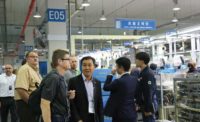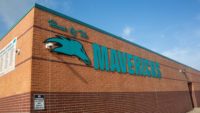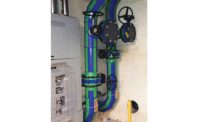Schnackel Engineers and Red Robin Gourmet Hamburgers have been great partners for more than a decade.
The Omaha, Neb.-based nationwide MEP firm and the national family restaurant chain have worked together on more than 650 facilities throughout the United States for the last 13 years. Dustin Wollenburg, a project manager with Schnackel Engineers worked on the Lakewood, Colo., location which opened in 2016, and is the latest eatery which Schnackel Engineers provided MEP services for the nationwide family dining company.
“Schnackel Engineers has enjoyed a great long-term relationship with Red Robin,” he says. “It has been very enjoyable because Red Robin is very knowledgeable and in tune to all aspects of their building systems. Communication has been great between all parties, which eased any possible coordination issues and ensured designs being completed accurately and efficiently.”
Recently, and with the Lakewood facility, Schnackel Engineers and Red Robin have utilized tankless water heaters for restaurant domestic water systems. The duo has utilized Navien tankless units exclusively for all new construction.
“The Navien NPE-240A was considered and then specified for Lakewood for a number of reasons,” says Dave Bailey, the Schnackel Engineers mechanical engineer on the Lakewood restaurant. “We needed as large a gas water heater as possible without breaking into the boiler designation by code. The unit’s small profile and the ability to easily cascade multiple units to create a larger overall system was another major factor in the selection process.”
Six NPE-240A units were installed – piped and plumbed in parallel – at the Lakewood Red Robin. Typically, according to Navien Specialty Channel Sales Manager Brian Fenske, five units are used at Red Robin facilities. But a sixth was required at Lakewood because of the expected patronage, lower gas BTU contents because of Colorado’s high elevation and the area’s colder groundwater. The units also feature ComfortFlow technology that pairs a 1/3 gal. buffer tank and an internal recirculation pump to provide instantaneous hot water to all the restaurant’s fixtures.
The six units were installed in two rows, one unit above the other because saving space was a critical issue for Schnackel Engineers and Red Robin.
“By decreasing the required footprint for installation and maintenance, we were able to maximize space usage in the back of the house area,” Bailey says. “These units also have an integral recirculation system that ultimately decreases the amount of equipment the client will need to maintain.”
The six water heaters act as a single unit and fire up only as needed to meet the Lakewood Red Robin’s demand. The system can provide anywhere between 20,000 to 1.2 million Btu/h. That roughly equals 0.1 to 30 gpm depending on incoming water temperature and fixture loads.
From on high
The Lakewood Red Robin restaurant sits 5,550 ft. above sea level, which could have been an issue, but the tankless water heaters have no issue performing. The NPE-240A units use DIP switches to change the air/fuel mixtures and the speed of the fan for the higher altitudes.
The HVAC system at Lakewood required some deft design from Wollenburg and his team. Wollenburg says locating all the mechanical rooftop equipment in a way that allows all the interior ductwork distributions to be efficiently installed while meeting code requirements was one of the toughest challenges.
“It required ventilation and makeup air separation from exhaust discharges at roof level,” Wollenburg notes. “We generally find limited roof space to place all the packaged rooftop units, makeup air units, exhaust fans, plumbing vents and water heater flues to meet required equipment service clearances.
“Every site is its own puzzle that has to be solved. We constantly are challenged to find the most efficient and effective layout for all components.”
The Lakewood Red Robin features a floating cloud ceiling concept that provided a special challenge for Paul Plouzek, a mechanical engineer with Schnackel and the HVAC designer for the facility.
“Integrating the ductwork and diffuser layout with the open ceiling and a floating cloud ceiling concept was difficult,” he says. “The goal was to minimize the visibility of the HVAC system by hiding it above the floating ceiling while maintaining adequate supply air distribution throughout the space.”
Custom computing
Another dynamic element of the design Schnackel Engineers provided for the Lakewood Red Robin was the use of its proprietary design software. The program takes into consideration a litany of information such as pipe runs, the outdoor elements of where the building will be constructed and much more.
“The design was completely computer-generated by our in-house design software known as AEA Integration,” Bailey states. “The software studies hundreds of design iterations and selects the most cost-efficient routing solution.
“Also, it further optimizes the design to meet the parameters for the particular location of the facility. Our software designs more energy-efficient MEP building systems using fewer construction materials, reducing both up-front costs and long-term operating costs.”
Bailey adds: “Based on our own case studies of several other projects, we have seen construction cost savings ranging from 5% to 25% less for MEP engineering designs using our AEA software than a conventionally designed system.”
Extending the relationship
The relationship between Navien and Red Robin has been growing since Fenske helped the company solve some issues other restaurants were experiencing dating back to 2013. Fenske notes Red Robin’s director of facilities called him to help with a few Red Robin restaurants in Oregon and Washington that were having some issues with hot water.
Fenske and Barry LaDuke, Navien’s northwest regional sales manager, toured five facilities in the Pacific Northwest in 2014 and found four of the five restaurants required a system resizing.
“The biggest problem was they were using two or three 199,000 Btu/h tankless units,” Fenske says. “In reality they needed four or five to meet the demand. The fifth site had four water heaters, which might have been sufficient if not for some installation errors.”
Fenske found each facility’s primary dishwashers were not equipped with a pressure-reducing valve, creating pressure-drop issues throughout the kitchens, as well as excessive hot water use.
Fenske’s continued communication led Red Robin higher-ups to visit the Navien headquarters in Irvine, Calif., in 2015. Red Robin received an up-close-and-personal look at the NPE-240A units and the partnership was in full bloom.
“Red Robin made a decision to work with us going forward,” Fenske says. “They planned to convert any problematic installations to Navien units, while standardizing on the NPE-240A for construction of all new restaurants going forward.”
Red Robin’s exclusive architect firm, Chicago-based Chipman Design, made modifications to the building design for all new future Red Robin facilities. The new layout calls for easier access to the hot water systems, including a mechanical room at the back of the structure with outdoor access. The new blueprint consolidates all the plumbing components and provides easy access for service personnel without having to walk through the active kitchens.
Fenske applauds Red Robin for being a proactive company and doing whatever is required to have a top-quality design – provided by Schnackel Engineers. In restaurants that may only need four tankless units to run smoothly, there are five units installed. A facility that needs five has six installed, and so on.
“Using an extra water heater not only ensures pressure drop is never an issue, but it also provides redundancy,” Fenske says. “Should a unit go offline for any reason, whether it be failure or planned service, the hot water system will be able to cover peak demand.”
Schnackel Engineers appreciates what Navien provides for Red Robin and itself on designs, including the Lakewood facility.
“Navien was responsive and very helpful during the design process,” Bailey says. “They’ve proven to be an extremely useful asset with an efficient design.”
Fenske credits Wollenburg, Bailey, Plouzek and the rest of team at Schnackel Engineers for making the Navien-Red Robin partnership a true success.
“The feedback we have received from all the restaurants has been very positive,” Fenske notes. “As time goes on and more units are installed, my involvement has been less crucial. I believe that is a testament to the ease of use of the units. It also is a testament to the talent of the engineers involved.”
This article was originally titled “Water priorities” in the May 2017 print edition of PM Engineer.








